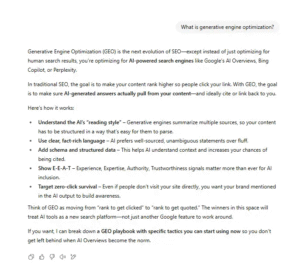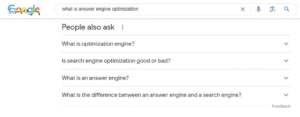
Welcome to the new reality, where AI thrives and shapes how users search, and if the brands fail to adapt, then they risk fading from the conversation.
A large number of people have bypassed search engines entirely and have turned towards large language models (LLMs) such as ChatGPT, Grok, and Perplexity to find answers.
We are standing at the threshold of a revolution that unites human curiosity with AI precision—and if you are not ready, your brand might lose the race.
Today, ChatGPT has become a conventional name for multiple LLMs from OpenAI, including GPT-3.5, GPT-4.0, and GPT-4.5.
With over 2.5 billion prompts per day and 120 million users daily, ChatGPT has become an integral part of everyday digital life.
So, where are we with the SEO? Is SEO dead in this zero-click environment and AI overviews?
Understanding SEO (Search Engine Optimization)
What is SEO?
Search engine optimization (SEO) focuses on boosting the website’s visibility on search engines like Google, Bing, etc. A better ranking on SERP means more organic traffic.

How does SEO work?
To achieve success with SEO, businesses rely on a range of techniques:
- Content Optimization Strategy: Compose helpful, informative pieces that solve problems or answer questions effectively. The user’s internet is the pillar around which content should be built. The focus should be on creating good quality content rather than stuffing keywords in the content.
- On-page SEO techniques: This technique includes activities such as keyword research, meta title and meta description optimization, heading optimization, and more. In short, it must align with the search queries.
- Off-page SEO strategies: Earning backlinks from reputable websites boosts authority, as each link serves as a vote of confidence that signals trustworthiness to search engines.
- Technical SEO checklist:
- Websites need to be fast, mobile-friendly, and free of errors. Focusing on technical elements like speed, mobile-first indexing, and seamless navigation creates a smooth, user-friendly experience.
- Local SEO Strategy: To improve rankings for location-based keywords, include the city name, add your address, and keep your Google Business Profile (GMB) updated.
Businesses that invest in SEO achieve lasting results, as it strengthens trust, authority, and user engagement for steady growth. Partnering with a professional SEO company helps fine-tune these strategies for even greater impact.
Understanding GEO (Generative Engine Optimization)
What is Generative Engine Optimization (GEO)?
Generative Engine Optimization (GEO) is the next step in how search engines handle and present information.
Is it related to SEO? The short answer: yes, it’s similar, but not the same.
Both GEO and SEO aim for visibility—while SEO targets search engine rankings, GEO ensures your content shines in AI-generated answers.
GEO showcases content across platforms, Google AI Overview, Bing Copilot, Perplexity.ai, ChatGPT search plugins, and other generative search engines or AI-powered summaries.
Instead of just chasing keywords, GEO ensures your content is structured, factual, and citation-worthy so it gets included in AI-generated answers.

How does GEO work?
To achieve success with GEO, businesses must work on:
- E-E-A-T Principles: Experience, Expertise, Authoritativeness, and Trustworthiness are key pillars of AI-friendly SEO. Applying EEAT principles helps content rank effectively while reinforcing credibility.
- Conversational Tone: GEO focuses on creating content that feels natural and engaging, as a human-like tone connects more effectively with both users and AI-driven engines.
- AI-Friendly Content: AI content marketing strategies prioritize crafting material that algorithms can easily understand and rank. Using AI marketing tools, businesses can analyze trends and user behavior to deliver highly optimized content.
What is Answer Engine Optimization (AEO)?
Answer Engine Optimization (AEO) is all about providing quick and direct answers to user queries.
Powered by tools like Google Knowledge Graph and amplified by voice assistants such as Siri and Alexa, the demand for instant results is growing rapidly.
Rather than scrolling through multiple sites, people now ask direct questions—and AEO ensures your content appears in featured snippets or voice search responses, delivering exactly what users need in seconds.

How does AEO work?
Businesses can apply Answer Engine Optimization (AEO) using these key strategies:
- Featured Snippets Optimization: Format content into clear lists, tables, or concise answers to increase the chances of appearing in snippets. Search engines rely on this structure to deliver quick responses to user queries.
- Voice Search Optimization: Since voice assistants like Siri, Alexa, and Google Assistant prefer natural, conversational language, use human-like phrasing that mirrors how people ask questions aloud.
- Schema Markup: Implement structured data to help search engines interpret your content. Marking up FAQs, reviews, and events makes it easier for search engines to surface relevant details directly in results.
By leveraging these AEO tactics, businesses can capture more direct searches and voice queries, ensuring users get answers faster than the competition.
Difference Between SEO, GEO, and AEO
SEO (Search Engine Optimization)
- Primary Goal: Rank in search results
- Tools Used: Keywords, backlinks
- Content Format: Blogs, web pages
- Audience: General searchers
- Tech Focus: Technical SEO checklist
AEO (Answer Engine Optimization)
- Primary Goal: Provide direct answers
- Tools Used: Schema, voice search tools
- Content Format: Q&A sections, snippets
- Audience: Voice search users
- Tech Focus: Featured snippets optimization
GEO (Generative Engine Optimization)
- Primary Goal: Optimize for AI platforms
- Tools Used: AI-powered content tools
- Content Format: Conversational, detailed
- Audience: AI-driven platforms
- Tech Focus: AI marketing tools
Core Similarities of SEO, AEO, and GEO
Here are the key similarities worth noting:
- Each works toward boosting online visibility.
- All emphasize delivering a better user experience.
- Depend on content optimization as a core strategy.
- Leverage data to drive performance improvements.
- Incorporate AI tools for smarter outcomes.
- Target user intent and behavior with precision.
- Focus on relevance and accuracy in results.
- Continuously adapt to changing search algorithms.
Where Search Is Headed in 2025: The Hybrid Future

The future of SEO in 2025 blends the old with the new. Traditional SERP rankings will still matter for many queries, but AI-generated responses are set to dominate others. Smart businesses are preparing for both—optimizing for search engines while ensuring their content is structured, trustworthy, and AI-readable.
What’s Next for SEO and AI Search
AI-powered search is evolving fast:
- Visual search is becoming more advanced.
- Personalization is reaching new levels of precision.
- Search experiences are shifting toward interactive, dialogue-based models.
Content that adapts to these trends—especially conversational and context-rich formats—will gain a competitive edge.
The Bottom Line
AI-driven search isn’t the future—it’s already here. The businesses that win in 2025 will be those that optimize for both humans and AI, build real authority, and embrace strategies beyond traditional SEO. The choice is clear: adapt now, or risk being left behind.